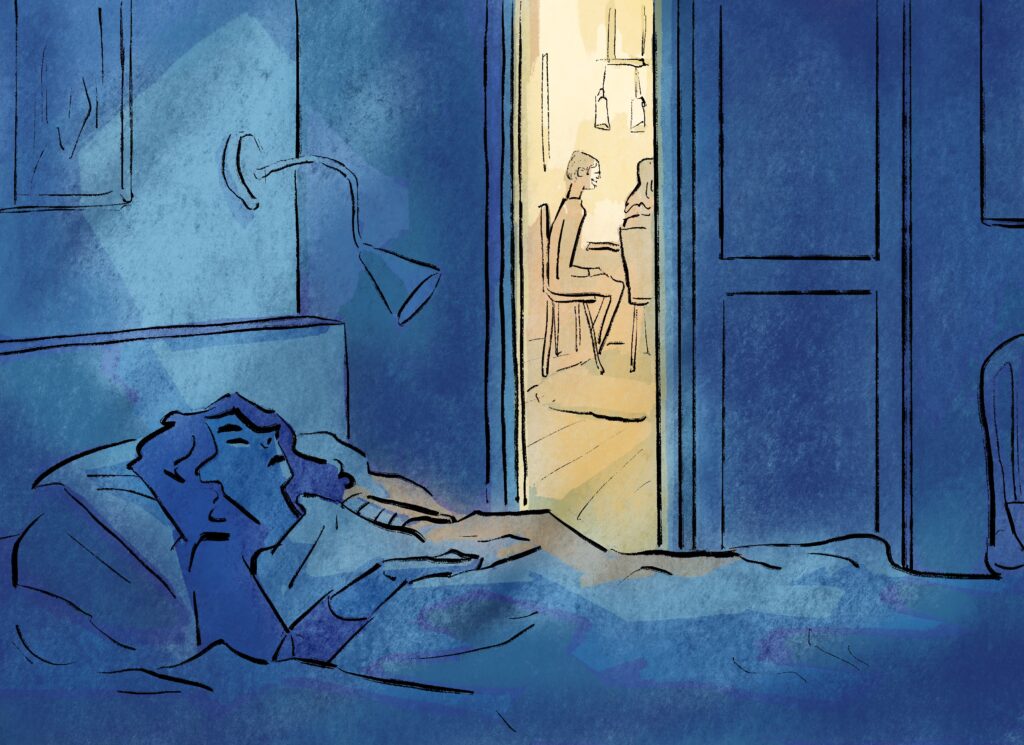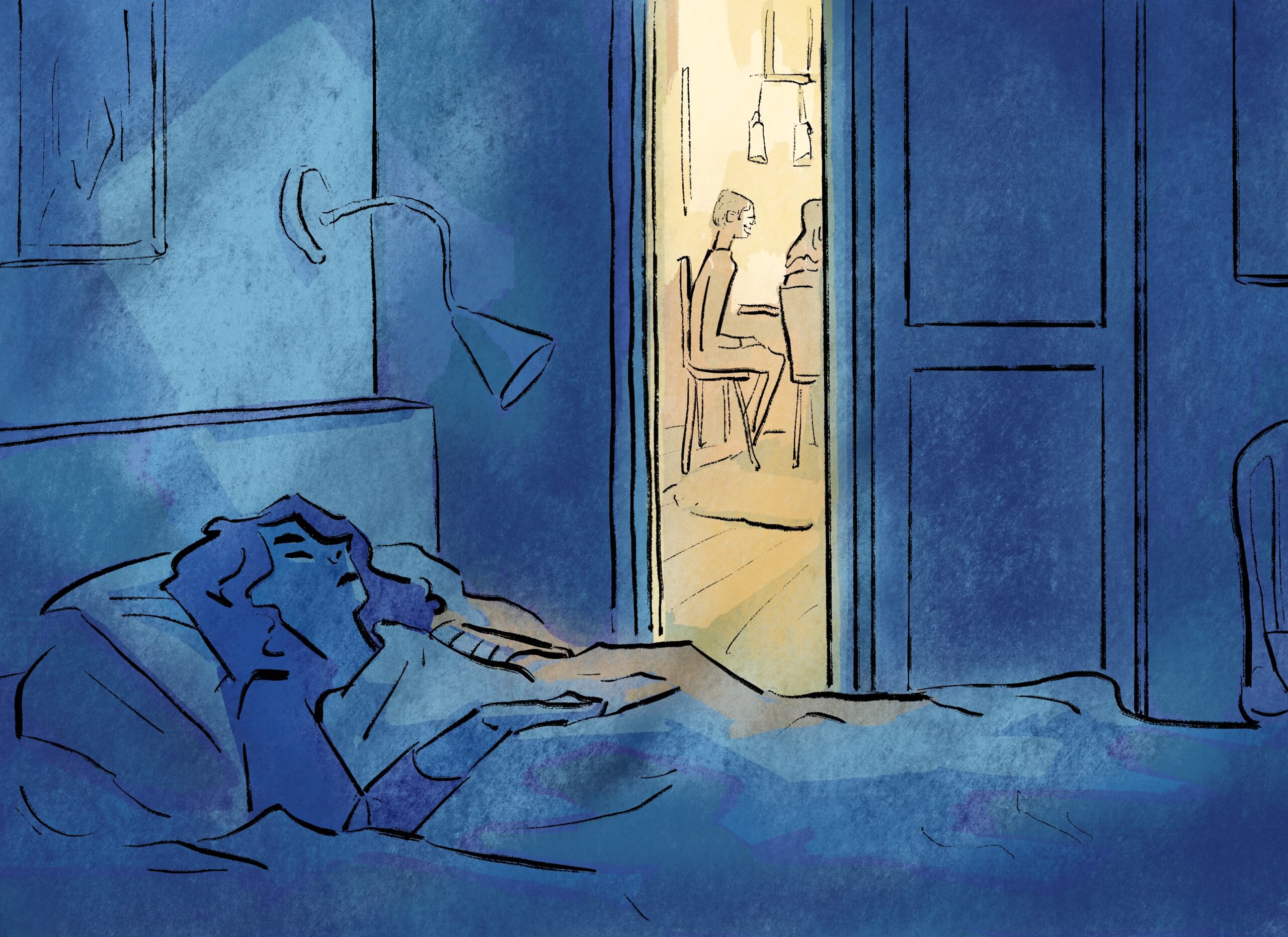Believe it or not, our current pandemic of post-infectious disease—long COVID—isn’t unprecedented. It has a little-known older sibling. Those affected have simply been left to suffer.
BY TIMOTHY COOKE
ART BY CALLIE SILVERTON
———————————————————–
A Life-Changing Diagnosis
Hailey Radigan was due at Toronto’s Women’s College Hospital (WCH) at 2 p.m. Her mother drove her there from their home in the city’s west end. Radigan wished she’d cancelled the appointment. To her, it was case closed: she had a thyroid problem; in time, the medication she’d just started would take effect. Deep down, she knew this was wishful thinking, but she wanted to keep living her fantasy regardless. After a short wait she was ushered into the doctor’s office, her mother accompanying her. Later, as she begins describing the appointment, her voice quivers. “I’ll get emotional when I talk about it,” she says. “It absolutely blows my mind—how I could go into a doctor’s office and have someone say my life’s over in a fifteen-minute session, and then be put out into the world with virtually nothing.” She told the doctor her condition hadn’t changed since their session six months ago. The doctor tried to let her down gently. It wasn’t just her thyroid—there was something larger at play. It was no use. The diagnosis was Radigan’s worst fear come true: myalgic encephalomyelitis/chronic fatigue syndrome (ME/CFS).
The doctor, although receptive and understanding, couldn’t offer much assistance beyond a bare-bones explanation of ME/CFS. An endocrinologist by training, she knew little about it. Radigan asked about treatment. The doctor looked at her apologetically. As far as she knew, Radigan could do nothing but wait and hope it faded, as sometimes happened. Radigan asked how long this might take. The doctor shrugged. Radigan’s mother asked about naturopathic remedies, about diet changes. The doctor encouraged them to try both but couldn’t guarantee anything. All she could do was refer Radigan to a YouTube video about the condition and recommend she apply to the WCH’s Environmental Health Clinic (EHC). It could help her manage her symptoms, but the waitlist was long. One of only three ME/CFS treatment facilities in Canada, Radigan says it can take three years to be admitted.
The Illness of the Present
ME/CFS is a common, devastating disease you’ve likely never heard of. It belongs, primarily, to a cruel category of illness: a debilitating, often post-infectious disease sparked by common, normally mild viruses. It’s the kind we all come across but generally resolve with little trouble. For some reason, ME/CFS patients don’t fully recover from them. Canada’s diagnostic criteria list five primary symptoms: persistent, unexplained exhaustion that won’t improve with rest; sleep dysfunction; pain throughout the body; cognitive dysfunction; and the condition’s telltale sign, post-exertional malaise (PEM), sudden flare-ups in symptoms following even the slightest physical or cognitive exertion. PEM’s onset can be either immediate or delayed, and it typically lasts 24 hours or longer. PEM is widely considered the most challenging symptom of ME/CFS to manage.
ME/CFS isn’t a death sentence. As things stand, the millions living with it globally have been sentenced to life—a lifetime of disabling agony and disappointment. This shouldn’t be the case. For decades we’ve starved this condition of attention and, most importantly, research funding. Consequently, it bears the following medical triple ‘distinction’: its exact causes are unknown, it has no diagnostic biomarker, and there are no known effective treatments.
Now more than ever, the ME/CFS community needs allies to share its burden of advocacy. Thanks to long COVID, also known as post COVID-19 syndrome, post-infectious disease is making headlines. What’s more, long COVID even seems to be related to ME/CFS. Although some COVID long-haulers improve in a matter of months, many do not. This second cohort meets the case definition of early-stage ME/CFS. Whether their condition is separate but similar to, or a subset of, ME/CFS is still uncertain. According to current estimates, at least half of long COVID cases progress to this ME/CFS-like illness.
“The millions living with it globally have been sentenced to life—a lifetime of disabling agony and disappointment.”
Governments have grasped long COVID’s threat—millions unable to work and requiring long-term medical care—and are investing in its research. This has the potential to further our understanding of ME/CFS too. “Instead of being an ugly stepsister, ME/CFS is now the illness of the present,” says Dr. Lucinda Bateman, founder and medical director of the Bateman Horne Center, an ME/CFS treatment facility in Salt Lake City. “The more we learn and the faster we learn about long COVID,” she says, “the more we can apply to ME/CFS.”
ME/CFS patients are frequently sick for years before diagnosis, and the exact viral trigger is often unknown. But patients enrolled in long COVID studies are in the early phases of their illness, and the virus responsible for their symptoms is self-evident. This presents researchers with an opportunity. “We’re now studying, for the first time, what is required to trigger ME/CFS,” says Professor Alain Moreau, who, as director of the Interdisciplinary Canadian Collaborative Myalgic Encephalomyelitis (ICanCME) Research Network, has been applying his expertise to long COVID. This could illuminate ME/CFS’ causes and help us devise effective treatments, even preventative ones. “We can see if there’s some rationale to act as quickly as possible in the months following this type of viral infection,” Moreau adds. As the first step, researchers would have to test out the findings of long COVID studies on pre-pandemic ME/CFS patients, many of whom have been sick for decades. All they require is the funding. That governments will provide this isn’t guaranteed. They’ve scorned ME/CFS before, hence the need for allies. By themselves, medical information and statistics won’t stir people to action. The most effective tool at ME/CFS advocates’ disposal might be far simpler: the personal testimony of patients.
Onset
The road to an ME/CFS diagnosis is often long and traumatic. Too many physicians are unaware of the condition. Too many mistakenly dismiss it as psychosomatic. On average, the process takes five to eight years. For Radigan, it was relatively short, but painful. Her illness began in fall 2019. Two years into her undergraduate degree at the University of British Columbia, funded by a full-ride scholarship, she had just arrived in Milan for a year abroad. There was a lot to do before the semester started (find an apartment, attend Italian language classes) but she relished the challenge. Her first couple of weeks there were a blur of late nights and new people. She then came down with a cold and stayed home for a few days. As it receded, several more frightening symptoms emerged: dizziness, a racing heartbeat, muscle aches, and exhaustion. Nevertheless, she felt compelled to go to class.

Lying in bed before her first trip to campus following her cold, Radigan felt okay. As she went about her morning routine, still fine. It started on the bus ride—dizziness, heart palpitations, exhaustion. She didn’t know how she’d get through all her lectures. She tried to reassure herself. Surely, she’d improve as the day progressed? During her first class, she followed along as best she could. But her body protested more and more. On top of everything else, her chest burned and her back ached. “You’re sitting but it feels like you’re running for a bus,” she explains. “Your body’s like, ‘You need to stop!’” She compares it to the after-effects of an all-nighter, only she’d had a full night’s sleep beforehand. This lack of explanation was alarming. She couldn’t comprehend why sitting in class was so draining. Naturally, doubts crept into her mind. What if, on some subconscious level, she was faking everything? She persevered until the end of the class, but went home before the next—something completely out of character.
“I know how to deal with stress. This isn’t stress. There’s something wrong with my body.” — Hailey Radigan
Over the next two weeks, Radigan skipped more classes, as well as social occasions. Often, she only left the house for groceries. It was all too familiar. As a teenager, she experienced a terrible bout of mono—fourteen months of exhaustion, only going out once a day, and sleeping twelve hours a night. Although she’d been told an infection could retrigger it, she didn’t think her mono was resurging. Her symptoms were different this time around. Just before leaving Canada, however, she’d been diagnosed with an iron deficiency, and was taking supplements. She hoped this explained her condition. Perhaps it had just gotten worse.
Radigan knew she needed a doctor. She first tried her luck in Milan. Italy’s healthcare provisions for tourists are difficult to negotiate at the best of times. When you don’t speak Italian and lack the energy to even sit in a waiting room, it’s impossible. She realized she had to pause her studies and return to Canada. Her general practitioner would help her figure everything out.
Initially, Radigan’s family doctor ordered various tests, checking her iron and vitamin D levels. At a follow-up appointment, Radigan learned that everything had come back normal. The doctor’s verdict: there was nothing physically wrong with her. Her symptoms were borne of stress and anxiety—her medical trauma, what with her experience of mono, was compounding everything. She just had to take some time off, but she could see an endocrinologist if she wanted to investigate further. The doctor said this with compassion. It still reduced Radigan to tears. “I have a full-ride scholarship. I have straight A’s,” she remembers saying. “I know how to deal with stress. This isn’t stress. There’s something wrong with my body.” The doctor immediately apologized: she hadn’t meant to suggest there was nothing they could do, and she would absolutely refer her to an endocrinologist. As Radigan left, she even congratulated her on the scholarship.
Months later, when she applied for disability insurance, Radigan received copies of her various doctors’ notes, including from that appointment. “She said, ‘I referred her to the endocrinologist, but I believe the patient is depressed.’”
Radigan saw the endocrinologist. More tests. Once again, nothing abnormal. She told Radigan if it didn’t go away, it was most likely chronic fatigue—a symptom characterized exclusively by exhaustion, from which the vast majority recover. She told her it would probably fade. They scheduled a follow-up for six months down the line. Radigan asked if there was any chance it wouldn’t go away. “She said, ‘Most people get better. It’s really unlikely that you won’t,’” she remembers. “I guess I was really unlucky.”
Prevalent, Disabling, Underfunded
As previously mentioned, ME/CFS is typically precipitated by a viral infection, often Epstein-Barr Virus, the cause of mono. Exactly how this happens, we don’t know. Researchers believe some people are genetically predisposed but have not yet identified the genes responsible. Until we resolve these questions, we must assume all are at risk. It seems to affect people of every age, ethnicity, race, and baseline health. Even though a significant majority of patients are female, males should take little comfort. ME/CFS’s prevalence means they’re still highly vulnerable.
To estimate prevalence in Canada, most use the annual, government-run Canadian Community Health Survey (CCHS). Among other things, each randomly selected participant must indicate, from a list of medical conditions, any diagnoses they’ve received in the past. The results are applied to the entire country. ME/CFS isn’t included every year, but the 2016 CCHS estimated 580,000 Canadians were living with it. This is likely a dramatic underestimate. As knowledge of the condition amongst physicians is so limited, most cases are missed. In 2020, Dr. Leonard Jason and his colleagues published a community-based study of ME/CFS prevalence in Chicago youth. Over 95 per cent of the cases the authors identified were undiagnosed. By comparison, in 2016, the Canadian Chronic Disease Surveillance System (CCDSS) recorded 594,730 ongoing cases of dementia and Alzheimer’s, Parkinson’s, and Multiple Sclerosis (MS) combined—conditions with quality-of-life scores similar to ME/CFS. Based on provincial and territorial health insurance records, the CCDSS is a more accurate measure of disease prevalence than the CCHS. Unfortunately, however, it does not include ME/CFS.
Overall, roughly 75 per cent of those diagnosed with ME/CFS can’t work full time outside the home. Twenty-five to 29 per cent are housebound or bedbound. Only five to 10 per cent recover. Still, it has received negligible research funding globally, especially in comparison to other diseases, such as Alzheimer’s, Parkinson’s, and MS. The reasons why are various. Conditions that disproportionately affect women, like ME/CFS, are often chronically underfunded. Also, the aforementioned belief that ME/CFS is a psychological rather than physical illness is still prevalent within the wider medical community. This leaves a significant number of research council adjudicators unreceptive to proposals about the condition’s pathophysiological characteristics. Even among adjudicators who reject this view, few have the expertise to properly assess ME/CFS submissions. While medicine is a hyper-specialized discipline, the condition is multifaceted, spanning the neurological, immunological, endocrinological, and cardiovascular systems. Overall, the lack of funding means there’s a shortage of researchers in the field, which only increases the funding deficit—a vicious cycle. All this amounts to one thing: to borrow Moreau’s phrase, ME/CFS is the “last medical enigma of the twenty-first century” for a reason.
Waiting, Wondering
As she awaited her next appointment with the endocrinologist, Radigan wanted to believe she’d get better. She fluctuated between hope and despair, depending on the day. As it happened, her cousin by marriage, Janessa Culliford, had been living with a similar condition for several years. She’d had to abandon a career in teaching and was largely housebound. As soon as she heard about Radigan’s illness, she saw the situation clearly: they were both experiencing ME/CFS.
Culliford visited Radigan’s family that Christmas—impressive, considering her condition. One evening, she sat Radigan down. She explained ME/CFS, its impact on her life, and how she’d learned to manage it. She told Radigan she likely had it too, but with a caveat. She believed that, given her experience of mono, Radigan had relapsing-remitting ME/CFS, which can happen for some patients, usually younger ones. Her symptoms might periodically disappear for a time, even for years. She interpreted Radigan’s childhood illness differently. What had begun as mono had transformed into her first ME/CFS episode. After a few years’ respite, she’d now entered her second.
“All she could do was cling to her one cold crumb of comfort—that her illness might relapse and remit.”
Radigan went into a full panic, sitting up in the basement late into the night, wondering how this could be happening to her. “I emotionally was not ready to hear that,” she says. “It was somebody confirming my worst fears and just talking to me like it was normal.” Eventually, she had to look at herself in the mirror and tell herself to calm down. All she could do was cling to her one cold crumb of comfort—that her illness might relapse and remit. She took this even further, though. If her symptoms could come and go, who’s to say they couldn’t disappear for good?
Soon, Radigan’s outlook returned to its previous, oscillating state. Sometimes she accepted Culliford’s prediction. Sometimes she questioned it, hoping that what she had wasn’t ME/CFS. She tried to rationalize it like this: Culliford had experienced chronic health problems—asthma, ankylosing spondylitis, and Crohn’s disease—before she developed ME/CFS. But, barring her mono, Radigan had been relatively healthy. So maybe she was sick with something else. She doubled down on this idea when, two weeks before the follow-up, she was diagnosed with a thyroid problem. The follow-up itself—the life-changing 15 minutes described earlier—confirmed Culliford’s theory. But the jury’s still out on whether Radigan’s illness will relapse and remit. Radigan applied to the clinic at Women’s College. She’s been waiting for an opening for a year and a half. Studies on hold, she scours the internet for ways to mitigate her symptoms—even piecemeal measures, such as stretching before bed. Few suggestions have come from her doctors. “Everything’s had to be me being like, ‘Well, I hope this isn’t a quack, snake-oil thing,’” she says. Her faith in the medical profession has suffered. She’s found that if your condition falls outside a doctor’s area of expertise, few will go the extra mile to help you, despite what Grey’s Anatomy suggests.
An Illness Misunderstood
Despite ME/CFS’s low recovery rate, since the late 1980s certain researchers and clinicians, particularly in the UK, have touted two ‘cures’: cognitive behavioural therapy (CBT) and graded exercise therapy (GET). The wider ME/CFS community—including clinicians, researchers, and patients alike—discredits both. They’re rooted in the erroneous belief, known as the cognitive behavioural model, that the condition is a psychiatric disorder and its physical symptoms are psychosomatic. “It’s a multi-systemic disease,” says Professor Simon Décary, a University of Sherbrooke physiotherapist who researches long COVID and ME/CFS care outcomes. “There are vascular, neuro-inflammatory, and postural problems. You can’t create these with your brain.” Understandably many patients do develop psychiatric symptoms, but they’re a consequence of their illness.
“Patients insist—and studies bear this out—that physical exertion only worsens their condition, often dangerously so.”
GET proponents believe “fears of exertion,” as well as physical deconditioning explain ME/CFS’s symptoms, and that physiotherapy will address this. But patients insist—and studies bear this out—that physical exertion only worsens their condition, often dangerously so. “New clinical practice guidelines do not prescribe graded exercise for this population,” Décary says. “Physiotherapists as a profession just need to take a step back and stop this.” Advocates of CBT argue that counselling will help challenge patients’ ‘belief’ in their illness. “I call them the CBT theologians,” says Professor Peter Rowe, director of Johns Hopkins University’s ME/CFS clinic. “They’ve not looked at the evidence. They’ve continued to promote this belief that ME/CFS can be treated just with counselling, which is nonsense.” For more reputable, experienced clinicians, current treatment is more a question of symptom management through medications and lifestyle changes. Generally, this is what Canada’s three treatment centres offer.
Treatment?
Sabrina Poirier, an ME/CFS patient advocate and research partner, has been sick for 13 years. Her diagnosis took six. With hindsight, she realizes its onset was gradual, following one or more viral infections. Once her symptoms seriously impacted her activity levels, she went to her family doctor. He ran some blood work, but everything came back normal. He told her not to worry. When her symptoms worsened, she returned. More tests. Still no sign of a problem.

Eventually, her GP referred her to a rheumatologist and a sleep specialist. She was diagnosed with fibromyalgia, a pain disorder and common comorbidity of ME/CFS. She underwent exercise therapy, which can be effective for fibromyalgia patients. However, it is ineffective—even harmful—for those with ME/CFS. Her condition steadily deteriorated. Her sleep specialist decided to refer her to a provincial clinic that diagnoses and manages complex, chronic illnesses, hoping that they could help. The clinic’s staff were the first to diagnose Poirier correctly—something for which she’s eternally grateful.
Poirier’s diagnosis was not the end of her struggle, however. Like many women experiencing chronic health problems, she had to fight to be taken seriously. At various points over the next few years, several of her clinicians hypothesized about the cause of her illness. They suggested that she was burnt out, overwhelmed from juggling her successful career in community development and her family, and that, therefore, her condition was perhaps psychological at its root. “Women want it all,” she recalls being told at one appointment. “But when they get it, they can’t handle it.” She thought this was sexist nonsense, but at this point she was so desperate that she felt she had no other option than to try to trust them, given their years of training and experience. At another appointment, a clinician opined that an unsatisfying personal life was possibly driving her illness. They recommended expanding her social network. This rankled, too. “I was like, ‘I’m a very social person. What’re you talking about?’” she recalls. Then, they wondered if her husband was paying her enough attention. “My husband’s wonderful. He was a doting husband before I got sick, and he’s a doting husband now,” she remembers saying. They even asked if she regretted having children. Completely shocked at the suggestion, she assured the individual in the strongest possible terms that she adored her children, that she lived for them. It wouldn’t be the last time she’d have to face this heartbreaking question at such an appointment.
To address the illness itself, Poirier’s clinicians initially recommended deep breathing, yoga, mindfulness, and psychotherapy. They seemed to imply that this approach could lead to a full recovery, if she gave it her all. Although Poirier’s commitment to it was total, her treatment wasn’t helping. Her activity levels were dropping fast. She knew she’d have to give up work soon. She worried about being a burden to her family. In her darkest moments, she felt afraid and deeply ashamed.
Medical Tourism
Poirier decided to do her own research, in case there was anything her clinicians didn’t know about. Through online ME/CFS support groups and scientific studies, she discovered that her program of care omitted something crucial—post exertional malaise (PEM), what she now knows to be the condition’s cardinal symptom. If she pushed too hard, she’d crash from the exertion. According to the community’s advice, she had to determine how much daily activity she could handle and then strictly adhere to that limit. Now she understood her symptoms’ severity—by continuing to work and exercise as much as she could, she’d been overexerting herself. “Up until this point I’d just been in a rolling crash,” she says. She began spacing out her activities and taking rest breaks in between. She’d learned one of the keys to living with ME/CFS: pacing.
After a few weeks of experimenting with pacing, Poirier started to see a slight reduction in her symptoms. She felt that she was onto something, but that she needed more guidance. From her research, she learned that a group of well-respected, US-based infectious disease specialists had opened a new ME/CFS clinic in California. As far as she could tell, their experience in helping patients manage the condition was second to none. She signed up eagerly.
“Poirier did cry, but her tears were bittersweet. She was so grateful—finally someone was telling her the complete truth about her condition.”
At Poirier’s appointment at the clinic, the specialist was refreshingly thorough. First, she went over Poirier’s full medical history. Then, she performed a NASA Lean Test, which detects orthostatic intolerance—a common symptom of ME/CFS, according to the CDC. The test takes up to 10 minutes. Poirier’s positive result came after only four. She almost cried. At last, quantifiable proof of a problem with her body, she thought.
Following more tests, they sat down for “a very honest conversation.” The doctor told Poirier her condition had likely been triggered by a viral infection. It was serious and complex and there was, as of yet, no cure. She had to accept she might never recover. They could try different medications and lifestyle changes to mitigate her symptoms, but it wouldn’t be easy. “She said, ‘If you’re willing to walk this path with me, I’ll walk it with you,’” Poirier remembers. The doctor went on: proper pacing would be essential, even her pared-back routine was still overloading her body. She needed to drastically reduce it, no matter how frustrating. Now Poirier did cry, but her tears were bittersweet. She was so grateful—finally someone was telling her the complete truth about her condition, finally someone was offering viable treatment options for certain symptoms. But she was also filled with anger and sadness. Having lacked access to clinicians with knowledge and experience of ME/CFS for so long, she couldn’t help but think about how much time had been wasted, the needless damage her exercise-based treatment had done to her health, and the dismissal and gaslighting she’d endured along the way.
Although Poirier’s symptoms are now more manageable, she’s still getting progressively sicker. She and her US doctor have occasional appointments over Zoom, so she can stay up to date with treatment suggestions, particularly medications. She then brings these to her clinicians in Canada to explore further.
A Careful Balancing Act
Pacing can be helpful but make no mistake, it isn’t a sustainable treatment. Patients need something more effective than simply doing nothing. Janessa Culliford, Hailey Radigan’s cousin, is capable of more, activity-wise, than most ME/CFS patients. But she has found that carefully conserving your energy for when you need or want it most only gets you so far. Even climbing a flight of stairs or a phone call can cause a short-lived flare-up at best and, at worst, a full-blown, multi-day crash. She tells me our interview could trigger either. An ME/CFS patient’s body is fickle. “You learn to live with a lot of disappointment with this disease,” she says. “A lot of constant disappointment.”
Sometimes life intervenes. Say your sink breaks and your landlord sends over a contractor on short notice. Culliford might need a couple days in bed to recover. Sometimes, you get carried away in the moment and overdo things slightly. For ME/CFS patients, it doesn’t take much for the adrenaline to kick in, making it easy to miss a flare-up’s warning signs. Early in Culliford’s illness, this was a regular occurrence. Although she’s more disciplined now, it still happens.
“Her body began to revolt. She felt lightheaded, nauseated, exhausted.”
During the summer, Culliford and a friend try to make monthly visits to the beach. They normally just sit in the shallows and relax on the sand. On one occasion last summer, they tried something different. Using pool noodles, they ventured further out and spent some time floating, chatting, and laughing. All was going well. Absent-mindedly, Culliford began gently half-treading water with her upper body, to keep her chin above the surface. It felt good to use her chest and arm muscles a bit.
After about 20 minutes things began to change. Suddenly, she felt tired and irritable. She wanted some space to be alone. Mystified, she went ashore while her friend stayed in. Lying on a sandy towel—rather than in bed where she’d be comfortable—made her feel worse. Beset with nausea, headache, and muscle pain, she wanted to go home but her friend loved the water and would be disappointed. While she alternated between beach and lake, Culliford tried to hold out until she was finished. She couldn’t understand why this was happening, which only made it worse. Eventually, she couldn’t take it. She slept while her friend drove them home.
Once home, Culliford slept a further two to three hours. That night, she had a fever, nausea, sore throat, blocked nose, headache, muscle pain—the works. She was down for the count for three days. She struggled to get out of bed to eat. She relied on meal replacements and easier-to-eat foods, such as chilli and stew. On day two, she realized what had triggered the crash. She was furious. “All that from treading water for 20 minutes with my arms?” she says. “I wasn’t even treading water fully. I was on a pool noodle.” Her upper body was sore for even longer.
Best Laid Plans
Sometimes, for no apparent reason, your plans fail. Culliford is a keen tenor saxophonist. A couple of years into her illness, she asked her then-boyfriend to invite some friends over for a jam. It was her favourite activity, but they only did it once every six months at most. To ensure she was at her best, she spent the two days beforehand in bed, napping and listening to audiobooks. She felt really good going into it.

When people started arriving, Culliford rose for a quick hello. She went back to bed while they chatted and set up in the basement studio, awaiting the first sounds of music. When she heard them, she showered, hoping to ride the adrenaline through the jam. Then, she went downstairs. She sat down on a speaker in front of the microphone her boyfriend had set up for her and strapped on her sax. He asked her to blow some notes to check the sound. But when he asked again a few minutes later, her body began to revolt. She felt lightheaded, nauseated, exhausted. “It feels like, all of a sudden, I’ve got these weights attached to my torso dragging me down,” she says.
No stranger to this feeling, Culliford started her often-successful process for dealing with it, confident she’d be able to join in soon. She ducked her head down, closed her eyes, and took some deep breaths. No change. She unhooked her saxophone and leaned forward, her head and hands on her knees, trying to get blood flowing to her upper body. No change. She sat on the floor, her back against the speaker, her knees bent up to her chin. No change. She crossed her legs and stretched out over them, yoga-style, to get closer to the ground. No change. She lay down on the sofa. No change. She closed her eyes, again. Still no change. Half an hour had elapsed. The jam was now in full swing. She realized she wasn’t going to recover. She apologized and returned to her bedroom. She slept for two, maybe three hours.
The jam was still going on when she awoke. She felt a little better, but not well enough to rejoin. She stayed in bed for the rest of the day, in her own bubble, trying to block out the world. “You feel cheated. Really, really cheated,” she says. “Like, what the hell, body? Seriously? This is what you’re going to get mad about? All I did was blow some notes.” She tries not to be too hard on her body, though. “It’s not deliberately being an asshole to make your life miserable,” she says. “It fights to survive. If you feel like shit right now, it’s because it’s trying.”

